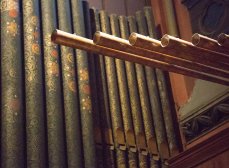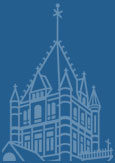
- Parish news
Update on the Organ Restoration Project
Not a day passes that I don’t dream about your magnificent instruments I played over there; their marvelous touch, their fine tone, their perfect and sensitive action haunt me. It seems as though I were dreaming when I think of Trinity Church, Boston, of St John’s, Los Angeles, Hollywood High School, Williamstown and Utica.
-Louis Vierne (1870-1937), organist of Notre Dame Cathedral, Paris
writing to Ernest Skinner after a 1927 United States tour
Trinity’s pipe organ is critical to leading worship. But, like so much else that occurs during church, we rarely stop to think about how critical. In a typical service, the organ sounds between 30 and 40 percent of the time: accompanying hymns, choir, psalms and all the other service music. When an instrument is so central to a church’s goals, it should be an inspiration to hear and play — as distinctive as Trinity Church itself. The current organ project has two central goals: flexibility and tone.
Flexibility: A New Console
In 1926, when the nave Skinner organ was installed, both organs were governed by a tall console on the north side of the chancel. Its cloistering height complicated the player’s ability to conduct the choir, and its primitive combination memory made governing what was then Boston’s largest organ: a tall order.
In 1956, a new console was provided, now on the south side of the chancel. From this vantage, players could hear the chancel organ and choir in better balance, and the console’s low profile permitted easier conducting from the console. Designed by George Faxon, Trinity’s eminent Organist and Choirmaster from 1954-1980, this new console was a marvel of its time, as miniaturized as the old console had been large, and with numerous features special features. In some instances, the reduction measures were drastic, even to the point of reducing the keyboards from four to three. In several instances, multiple stops were controlled by a single knob; certain stops were unavailable on their own.
In time, many players found these space-saving measures limiting. The new console, which arrived in August 0218, is only marginally larger than the 1956 one, but once again contains four keyboards and individual knobs for every stop. The latest technology includes a sophisticated combination memory system, user-definable options via iPad, and a record-playback function. This last feature is most useful, as it allows organists (particularly visiting artists) to hear their own playing from the nave, as the congregation does, and thus judge balances, adjust tempi, and refine the choice of stops. As with the prior one, the new console is on an especially handsome mobile platform, movable to the center of the chancel for solo concerts.
The new console was built by Richard Houghten of Milan, Michigan, and J. Zamberlan & Co., in Wintersville, Ohio. Mr. Houghten has worked at Trinity before, in the 1980s converting the organ’s original electro-pneumatic controls to its first solid-state system. In Boston alone, he has worked on the consoles at St Paul’s Cathedral; The First Church of Christ, Scientist, Extension (Mother Church); Harvard University; Park Street UCC in Arlington. Mr. Zamberlan has helped Mr. Houghten construct new consoles for Duke University Chapel, Christ Church Cathedral in Houston, and River Road Church (Baptist) in Richmond. Richard Webster, Colin Lynch, and Trinity’s curator of organs Jonathan Ambrosino, all had an active role in the design.
Tonal Splendor: Recapturing the Skinner Sound
One of the glories of Trinity Church is that Richardson’s resplendent interior has never been lost to subsequent modification, thus keeping at bay the tide of modernism and its “less-is-more” philosophy. Not so with the organ, which after 1926 was revised to keep in tune with the musicological times. In tonal terms, this meant an ever-leaner sound thought to be clearer for the music of Bach, and more transparent for choral leadership. Along the way, however, the grand richness of the original 1926 Skinner ensemble was lost, although Skinner’s characteristic orchestral colors (French Horn, English Horn, Celesta, vibrant strings) were retained. (Mechanically, the Trinity organs have always been maintained in excellent condition.)
The current project seeks to recast the nave organ along its original 1926 lines. Since 2012, the Church has gradually acquired a stockpile of Skinner and Aeolian-Skinner pipes from the general period of Trinity’s organ (1923-1934). This work is a collaboration of Trinity’s former and current organ curators: Foley-Baker Inc., of Tolland, Connecticut (who renovated the nave organ in 1999-2001, and the chancel organ in 2007), and Jonathan Ambrosino, who also maintains the organs at Old South Church and Church of the Advent. Foley-Baker is handling the larger pipes, installing not only a vintage 16ft Open Wood stop but also re-activating the southern green-painted façade pipe, which date from 1877 but have not been heard since 1926. Mr. Ambrosino is handling the remainder, reconditioning the vintage pipes Trinity has purchased, fitting them to the mechanisms, and installing them at Trinity. At the conclusion of the project (November 2019), he and his team will regulate and re-tune all the pipes. A key additional firm is Broome & Co. LLC, specialists in the reconditioning of reed pipes.
The goal here is not a louder organ, but something more supportive of the human voice. In the increase of brilliance and brashness over the years, the Trinity organ has become less encouraging in its support of singing; when the organ starts blaring, the people stop singing. A warm, rich, supporting sound, one that is strong, ceremonial yet not overpowering, will help lift the congregations and choirs of Trinity Church to their greatest heights yet.
-Jonathan Ambrosino & Colin Lynch

